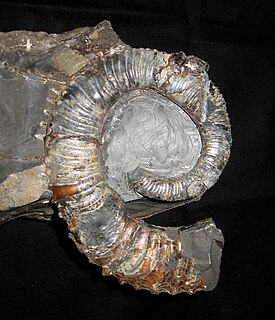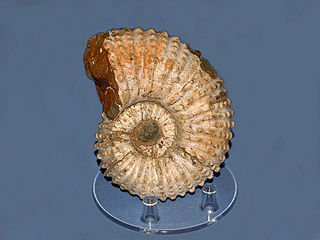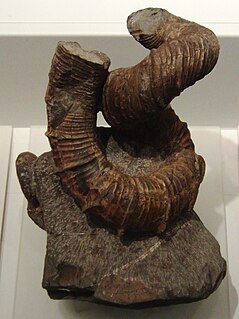Related Research Articles

Ancyloceras is an extinct genus of heteromorph ammonites found throughout the world during the Lower Cretaceous, from the Lower Barremian epoch until the genus extinction during the Lower Aptian.

Cimolichthys is an extinct genus of 1.5- to 2.0-meter-long nektonic predatory aulopiformid fish.

Placenticeras is a genus of ammonites from the Late Cretaceous. Its fossils have been found in Asia, Europe, North and South America.

Exiteloceras is an ammonite genus from the Late Cretaceous.

Douvilleiceras is a genus of ammonites from the Middle to Late Cretaceous. Its fossils have been found worldwide, in Africa, Asia, Europe, and North and South America.
Ogmodirus is an extinct genus of plesiosaur found in the Cenomanian-Turonian Greenhorn Limestone of Kansas. It may be member of the Elasmosauridae, a group of marine animals related to Elasmosaurus, but the condition of the fossils discovered to date means the genus is dubious beyond Plesiosauria. The type species, O. martini, was named by Samuel Wendell Williston and Roy L. Moodie in 1913. The original specimen consisted of a pelvic girdle, limb elements, and more than fifty cervical (neck) vertebrae discovered in Cloud County, Kansas. A second species, Ogmodirus ischiadicus, has since been referred to Styxosaurus. Sepkoski (2002) assigned Ogmodirus to the Plesiosauria.
Wrightoceras is an extinct genus of cephalopod, belonging to the Ammonite subclass, that lived during the Turonian epoch of the Late Cretaceous.
Oshunia is an extinct genus of prehistoric bony fish that lived during the Albian. Fossils of the genus were found in the Romualdo Formation of the Araripe Basin, northeastern Brazil. Other authors assign a Cenomanian age to the fish.
Prymnetes is an extinct genus of prehistoric bony fish that lived during the Late Cretaceous epoch.
Mesoclupea showchangensis is an extinct ichthyodectiform ray-finned fish that lived in freshwater environments in what is now China during the Early Cretaceous epoch. It differs from its sister genus, Chuhsiungichthys, primarily by having a more posteriorly-placed dorsal fin.

Eubostrychoceras is a genus of helically wound, corkscrew form, heteromorph ammonite which lived during the Upper Cretaceous. The genus is included in the ancycleratid family Nostoceratidae.

Macroscaphites is an extinct cephalopod genus included in the Ammonoidea that lived during the Barremian and Aptian stages of the Early Cretaceous. Its fossils have been found throughout most of Europe and North Africa.

Pachydesmoceras is a genus of ammonites belonging to the family Desmoceratidae.

Calycoceras is an extinct genus of cephalopods belonging to the subclass Ammonoidea and family Acanthoceratidae that lived during the Cenomanian stage of the Late Cretaceous, 100-94 Mya. Their shells had ornate ribs.

Pterorigonia is an extinct genus of saltwater clams, marine bivalve molluscs in the family Megatrigoniidae. This genus is known in the fossil record from the Jurassic period Tithonian age to the Cretaceous period Maastrichtian age. Species in this genus were facultatively mobile infaunal suspension feeders. The type species of the genus is Pterotrigonia cristata.

Phyllopachyceras is an extinct genus of ammonoid cephalopods belonging to the family Phylloceratidae. These nektonic carnivores lived in the Cretaceous, from Hauterivian to Maastrichtian to age.

Kossmaticeras is an extinct ammonoid genus belonging to the desmoceratacean family Kossmaticeratidae. Species in this genus were fast-moving nektonic carnivores. They lived during the Late Cretaceous, from upper Turonian to upper Maastrichtian age. The type species of the genus is Ammonites theobaldianus.

Silesites is an ammonite genus placed in the family Silesitidae. Species in this genus were fast-moving nektonic carnivores. They lived during the Cretaceous, in the Barremian age. The type species of the genus is Silesites seranonis .

Vascoceras is an extinct genus of Cretaceous ammonites included in the family Vascoceratidae. These fast-moving nektonic carnivores lived in the Cretaceous period from the late Cenomanian to the early Turonian. The type species of the genus is Vascoceras gamai from Portugal.

Oosterella is an extinct ammonoid cephalopod genus belonging to the family Oosterellidae. These fast-moving nektonic carnivores lived during the Cretaceous, from the upper Valanginian age to the lower Hauterivian age.
References
- ↑ Sepkoski, Jack (2002). "Sepkoski's Online Genus Database" . Retrieved 2014-05-28.CS1 maint: discouraged parameter (link)
- Marcinowski, Ryszard. Change within ammonite assemblages from Mangyshlak mountains (western Kazakhstan) during the mid-Cretaceous transgression. Institute of Geology of the University of Warsaw.
- Cooper, Michael R.; Owen, Hugh G. 2011. The phylogeny and classification of primitive Placenticeratidae (Cretaceous Hoplitina, Hoplitoidea).